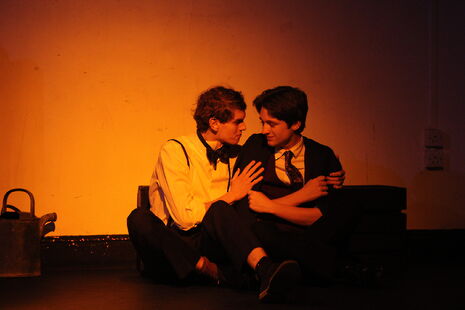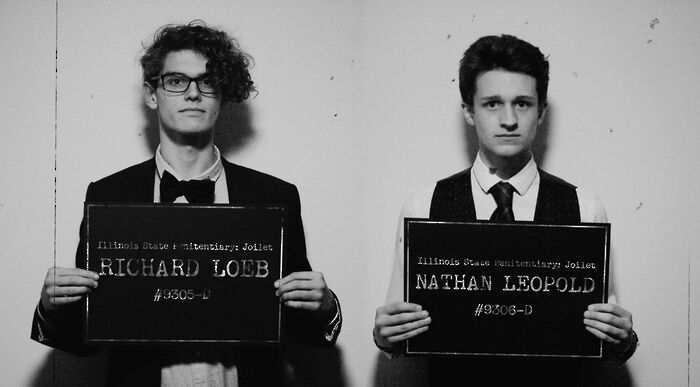Thrill Me is thrillingly entertaining
Louise Dai’s production of the musical based on the Leopold and Loeb case is effective and exciting.

Thrill Me: the Leopold and Loeb Story tells the story of a crime which occurred in Chicago in 1924 and was soon labelled ‘the trial of the century’. Two wealthy Chicago University students, gay lovers Nathan Leopold (Alex Hancock) and Richard Loeb (Joseph Folley), kidnapped and murdered 14-year-old Bobby for no other reason than wanting to commit ‘the perfect crime’. Director Louise Dai and Musical Director Daniel Quigley put their own spin on the musical written and composed by Stephen Dolginoff, which illuminates the relationship between the two self-acclaimed superior men and the motivations that led to the crime that shook the nation.
With the grey brick wall background, the four dark crates, and the period props such as telephones and a typewriter, Set Designer Craig Stewart and Stage Manager Niamh Gray provide an atmospheric set indicative of 1924’s Chicago. All props used throughout the production are displayed on a shelf throughout: we see the telephones, the big leather bag carrying the men’s pry bar, rope and acid for their eventual kidnapping of the boy and which create, to some extent, transparency. Two requisites which are left unused on the shelf, a teddy bear and a taxidermied crow, foreshadow the men’s crime and are symbolic of the boy’s murder. Despite the audience getting the impression they are on the same page as the two criminals when it comes to the events outlined, we later learn that one of them was actually one step ahead, and one prop in particular, unobtrusively and cleverly introduced before, held more meaning than previously thought.
“Dai’s decision to portray the men as equals, in contrast to earlier productions of the musical, is successful.”
Although the costumes (design by Stella Kirkpatrick) were slightly too modern for the 1920s setting, they emphasised Leopold and Loeb’s characters and drew out the differences between the two men. They showed Leopold as more composed and conscious than Loeb, for example, when the former helps the latter get dressed after another erratic moment. In this regard, the character’s use of their costumes emphasises Dai’s decision to portray the men as equals, in contrast to earlier productions of the musical. Her turn on the story is successful and Hancock and Folley carry the story equally, with regard to their character’s focus and their acting and singing. An important factor contributing to this equalisation is Dai’s use of symmetry; she makes use of the Corpus Playroom’s layout, often having the characters facing one part of the audience each.
Moreover, Hancock and Folley often move on the diagonal of the stage, thus facing both audiences to the same extent. They are also often situated in the centre of this diagonal, facing Quigley sitting in the corner between the two audiences and accompanying the whole musical on keyboard. As a result, Thrill Me depicts the constant negotiation of the relationship between Leopold and Loeb. As is Dai’s aim, the audience remains unsure as to the men’s motivations and intentions until the end. In the 1924 storyline and the second storyline, set 30 years later and showing Leopold at a parole court hearing, Hancock’s Leopold appears contradictory and unreliable, letting us wonder whose side of the story we really can trust and who of the two men will prevail over the other in the end.
On a technical note, the lighting by Ella Pound greatly enhances the atmosphere. When Loeb convinces Leopold to commit their first crime - the burning down of a warehouse -, the raging flames of the growing fire are aptly indicated by the flickering orange light. The spotlight on Hancock, positioned in the centre of the stage, also makes it easy to distinguish between the two time frames. The four crates are moved and positioned differently to create different spaces in 1924, a simple but effective way to not only keep the musical dynamic but also indicate the changes of scenes, which would otherwise be difficult to follow due to the almost continuous music played by Quigley. The characters' positioning on and around the crates also mirrors their relationship, showing them as more closer or apart at times.
The men’s passionate, dysfunctional relationship is further mediated by the two actor’s acting. While the script situates Loeb as more verbally dominant, this production made sure to establish Leopold as dominating physically and Hancock employs his body to non-forcefully steer Loeb into the direction he wants him to. At first, Leopold appears insecure and naïve, Hancock is playing him rather stiff and slightly hunched. Later, however, he becomes more aggressive shown by Hancock’s more upright posture and use of his hands to non-forcefully manipulate Loeb. On the contrary, Loeb at first appears very self-secure, a player. Folley plays him in a nonchalant way but soon lets Loeb’s façade crumble and reveals a broken man. Both actors perform great in solos and duets, and as I overheard someone say outside the theatre, although they had some off notes, they had great chemistry. Their voices complement each other and their singing made the catchy songs stick in my head. Hancock and Folley are able to easily carry the difficult topic, with some moments that made me smirk.
Compliments also to Quigley for playing almost continuously throughout the play. All three were in sync and on point which made for some great moments and a very professional impression of Thrill Me. I had not seen a musical in a while, especially none with only two performers, but Thrill Me exceeded my expectations with its fast-paced plot, engaging actors, and catchy musical numbers.
 News / Uni Scout and Guide Club affirms trans inclusion 12 December 2025
News / Uni Scout and Guide Club affirms trans inclusion 12 December 2025 News / Cambridge study finds students learn better with notes than AI13 December 2025
News / Cambridge study finds students learn better with notes than AI13 December 2025 News / Cambridge Vet School gets lifeline year to stay accredited28 November 2025
News / Cambridge Vet School gets lifeline year to stay accredited28 November 2025 Science / Did your ex trip on King’s Parade? The science behind the ‘ick’12 December 2025
Science / Did your ex trip on King’s Parade? The science behind the ‘ick’12 December 2025 News / Pembroke to convert listed office building into accom9 December 2025
News / Pembroke to convert listed office building into accom9 December 2025









